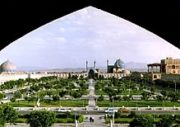In Iran, 6
This is a continuation of the series, “10 Days in Iran,” on our 12-person tour with The Nation magazine. Previous notes have discussed the urban density of Tehran and our visit to the carpet museum; the world-historical importance of Iran and its influence on our world today; Shi’ism’s rule and its contradictions, including contestatory art; the urban tradition and the curious exception of an underground “city”, and the importance of weaving for reproducing and holding together a culture. For those earlier notes, go to Day 1 here or keep clicking “Previous” at the bottom of this and earlier pages till you get there.
The great prize and most anticipated stop in our tour — especially for the three architects among us — was Isfahan, the height of Iran’s ancient imperial splendor, with its palaces, bridges, mosques and gardens and, especially, its great open plaza, the widest and longest in the world for many centuries and still unsurpassed by any but Beijing’s Tienanmen Square.
All that was wonderful, and a way of deepening the impression of the great power and artistic sensibility of this ancient culture, seedbed of further innovations so often attributed to Greeks, Turks, Romans, Arabs, Indians or Chinese. But for me, the most memorable event was our visit to the Music Museum, followed by a concert by five of the musicians on traditional instruments. Alas, my videos of their performance are too heavy to upload here (I did post one on Facebook), but here is a video of a similar concert in the Isfahan Music Museum by five other musicians.
